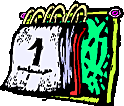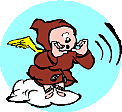With The Commentary of the RABAM

On this holiday, the yuntif of Shavuois, we celebrate two things:
the giving of the Toirah by the Aimishteh, and lactose intolerance.
Yuntif = Yom Tov, Yontef (various spellings possible). Yiddish for holiday, festival day.
Shavuos = Weeks; being seven weeks and one day after Peysach, a week of Sabbaths. The holiday is also called Chag Ha Katsir (the festival of reaping), Zaman Matan Torateinu (the time when we received our law), and Yom Ha Bikkurim (Day of First Fruits). Vayikra (Leviticus) 23:15 "You shall count seven entire weeks after the day following the holiday..."
Chag Ha Blintzim (stuffed pancake festival), as another name (all festivals should have multiple names; confusion is the first step towards enlightenment) has not caught on yet, but im yirtze Hashem it will.
Lactose intolerance = Discrimination against dairy; denying dairy the vote and other basic rights. Refusing to serve dairy. We don't like dairy!
A physical condition characterized by a lack of the stomach enzyme (lactase) needed to digest the natural sugar in dairy products, found mostly in people of East Asian ancestry, to a lesser extent in other peoples, and least of all among Scandinavians. Symptoms are usually gastric distress, manifested as bloating, cramps, gas, and loose stools. You should know this, before you start dating that shiksa.
Why do we stay up all night to learn Toirah -- also known as Tikkun Layl Shavuois? According to RASHI , we do this to commemorate the fact that Klal Yisroel stood earnestly at the bottom of Har Sinai as Moishe Rabeinu met the Reboinoisheloilum face to face at the top of the mountain, and all that could be heard were bolts of lightling, claps of thunder, the rustle of the wind, and the sounds of concessioners looking to make a buck: "Hot dogs, get your kosher hot dogs!" "Get your program -- Mattan Toirah commerative program!" "Bring home a stuffed Toirah to you kids! One of a kind! They'll never be available again!"
Tikkun Layl Shavuos = Rectification of the night of Shavuos; the story is that on Shavuos the Aimishteh visited his people, but they overslept. Since then, to make up for that oversight, it is customary to stay up all night studying.
But another story says that on Shavuos we received the law (after Moishe finally came down from the mountain), and to prepare ourselves for that momentous event, we need to study. Torah is composed of a written component (Torah She Biktav; law which is written) and an oral component (Torah She B'al Peh; law which is in the mouth). That latter term implies the need to discuss, to recount, and to be able to intelligently analyze - hence the need hear and the need to study, as is implied in our saying when we received the Torah “we will do and we will listen (na’aseih ve nishma).
Sounds of concessionaires = According to Rabbi Abdimi Bar Chama, it is because of their infernal racket that the Aibishter held mount Sinai over our heads, saying "shut up already or I'll drop this on you!" Why Sinai? It is said that the Aibishter considered several other mountains, but each had a character flaw, or was too arrogant, or had been associated with heathen practices, so in the end he chose Mount Sinai, which did not consider itself too tall, or too beautiful, or too important, but was honestly pleased to be a part of the event.
But according to the Bais Yoiseph, Shavuois is essentially a test of Klal Yisroel's commitment to Toirah values. And to celebrate this, we stay up all night to cram for the test.
The Ramban holds that Hashem wanted to test the Bnei Yisroel to see if they would follow the mitzvos, and explains the giving of the Toirah as a challenge, based on the standard reading of nasot et-chem as 'to test y'all', whereas Rashi prefers to read it, almost poetically, as 'to raise y'all. This from Shemos (Exodus) 20:17 "Va yomer Moshe el ha am 'al-tira'u ki le va'avur nasot et-chem ba ha Elohim u va'avur tihiye yirato al-peneichem levilti techeta'u" (And Moses said to the people 'do not fear, for G-d comes to test y'all, so that awe ( ) may be before y'all, (and) so that y'all won't sin.'). Both interpretations are correct - elu v'elu, divrei Elokim chayim (this and this, (both) are the words of the living Reboinoisheloilum.
And as you stay up all night, you had better pay attention. A braisah in Bubba Basra tells a story of the Tannah Kamma, who was learning all night in the bais medrish with his students. Suddenly, one of the talmidim pointed out the window and said, "Look -- it is light outside. It is time to recite the Keriyas Shma!" The Tannah Kammah, with a very serious look on his face, rushed over to the window where his student was standing, grabbed him by the ear, and twisted it until it started to bleed. "Stop looking out the window during my shiur, you schmendrick!" the Tannah Kamma declared. He then forced the student to recite Pesukai Dezimrah in front of the congregation for a week.
(Tannah Kamma = The anonymous commentator (sing. Tanna. Plur. Tannaim) of the Bava Kamma (one of the three ‘gate’ tractates in the Talmud, which deal with civil law. Time to recite the Krias Shema = When it is light enough that you can tell the blue threads from the white in your tallis (prayer shawl).
Krias Shema = Reciting the Shema Yisroel and its blessings.
The Shema (Shema Yisroel, Adonai Eloheinu, Adonai achad, is the quintessential Jewish statement of faith, the battle-cry in struggles, the last comfort of the dying. The blessings are by tradition ascribed to the men of the great assembly. Reciting the Shema and the blessings fulfills the commandment to meditate on the laws ‘day and night’, as is written (Joshua 1:8): "Lo yamo'ush sefer ha Torah haze mi picha, ve hagita bo yomam va leila le maan tishmor la'ashoot ke chol ha katuv bo ki az tatsliach et derachecha ve az taskil" (Let not leave from your mouth this book of laws, but that you consider it day and night, that you may obey all that is written in it, and make your travails prosperous, and succeed.).
This is also said in Devarim (Deuteronomy) 6:7 "Ve shinantam le bneicha, ve dibarta bam be shivteicha b'veiteicha, u velechteicha va derech, u veshachbeicha u vekumeicha " -- "And you will teach them diligently to your children, and discuss them when you sit in your home, and when you walk on the road, and when lie down and when you get up.".
Schmendrick = One who is kin and intermediate to a shlemiel (passive sad sack), a nebbish (a born loser), and a shlimazl (one who has all the luck, meaning none of the luck).
Pesukei d'zimrah = Verses (psukim) of praise, exaltation of G-d, recited before krias shema at morning service, which just the leader says aloud. Each word must be enunciated clearly and with kavanah (intent, sincerity, feeling).)
The RADAK has a beautiful interpretation of Tikkun Layl Shavuois, which takes a completely different approach. According to the RADAK, Shavuois night gives us the opportunity to initiate an extramarital affair, continue it over the summer while your family is away in the bungalow colony, and break it off just in time to repent on Rosh Hashana.
Radak = Rabbi David Kimchi (1157 - 1236), philologist, commentator, scholar, from Narbonne in France, who wrote books of grammar, a commentary on Tanach, and an etymological dictionary of Hebrew. He was the son of Rabbi Yoisef Kimch, and the brother of Rabbi Moishe Kimchi, who were also philologists and scholars of note.
Rosh Ha Shana = New Year, which in this year (2005 C.E.) will be on October 4th.
As proof, the RADAK cites a medrish in the Medrish Tanchumah that tells how Rabbi Akiva used to "visit" the wives of his talmidim at their homes on Shavuois night, while the talmidim were up all night listening to a shiur delivered by his assistant rabbi on exactly which shoe to put on first every morning.
Rabbi Akiva = A scholar from the Roman period. Medrish Tanchumah = Yelamdinu - a collection of midrash or derivational commentary on Tanach compiled between 400 and 800 C.E.
But what does all of this have to do with eating dairy? In a gemarrah in Maseches Soitah, Abaya suggests that we eat dairy lehachis, because it is almost summer and the goyim have all started to barbecue in their backyards and WE DO NOT ACT LIKE THE GOYIM!!!
Gemara = An exegesis of a Mishnaic (singular: Mishna) passage, which often is anecdotal in form. Note: not all Mishnas have gemores.
Sotah = An adulterous woman.
Maseches Sotah = The fifth tractate in the Seder Nashim (order of women) in the Talmud (which has six orders, altogether 63 tractates).
Abaya = An amora (exegete and explainer of the Mishna) from the talmudic era, died 339 C.E. Successor and nephew of Rabba bar Nachman as head of the academy at Pumbedita in Bavel.
Lehachis = Annoyance; to annoy, to irritate, to rebell. Hence an act of rebellion or defiance, such as reading the Talmud was for several centuries (during which time, reading by itself was also an act of defiance; I'm sure you can figure out what I mean).
But others say that the reason we eat dairy is because there was no kosher meat on that day, the laws of kashrus having been learned too recently to permit kashering of utensils and proper schechita, whereas the containers used for milk and its derivates were considered tohor.
Rava disagrees. He suggests that we eat dairy to commemorate the miracle of Yehudis killing an enemy general by seducing him, giving him salty cheese to make him thirsty, getting him drunk, and then cutting his head off. (On this itself there is a disagreement of interpretation. RASHI holds that the general was killed because he was an enemy of the Jews; but TOISFOIS holds that Yehudis killed him because he left her "unsatisfied" at the end of their encounter, if you know what I mean. Rachmanah letzlan.)
Rava = The study partner (chaver) and successor to Abaya as head of the academies in Bavel Born circa 270, died 350.
Yehudis (Judith, daughter of Yochanan HaKohain, widow of Menashe) gave Holofernes (an Assyrian general who was besieging the town of Beituliya during the Maccabean wars) salty cheese to eat, which made him drink intemperately and become insensate, whereupon she whacked off his head with his own sword, stuffed it into her bag, and hightailed it back to town. Shortly afterwards the townsmen swarmed out and attacked the Assyrians, who, finding themselves headless, fled helter skelter. Those that weren't slaughtered, that is.
Normally this inspiring tale is celebrated at Chanuka, which, like Shavuos, is also a chag which we celebrate for the heck of it. Note that several Italian painters have illustrated Yehudis holding up Holofernes head, or chopping it off, or stuffing it in a bag, or speeding towards the city holding it up in triumph. Lovely.
Toisfois = Tosafos; the commentators who followed Rashi of Troyes (Rabbi Shlomo Ben Yitzhok, 1040 – 1105), the great mediaeval exegete.
But according to the Brisker Ruv, there is actually a direct correlation between the receiving of the Toirah at Har Sinai and our preference for dairy on the holiday. 3500 years ago our ancestors longingly stood at Har Sinai, as Moisheh ascended the mountain to receive the Toirah from the Reboinoisheloilum. As the time whiled away and Moisheh did not return, the Jews began to panic. To help resolve the crisis, Moishe's minuval brother, Aron Hacoihain, demonstrated his loyalty by inciting Klal Yisroel to worship the Eigel. In other words, just as they were receiving the Toirah, the Jews were immediately rejecting it.
The Brisker Rov = Rav Yitzhok Zev (HaLevi) Soloveitchik, also known as ha Gaon Rabbi Yitzhok Zev and as Rebbe Velvel (Rebbe 'little wolfling' – Zev means wolf, velvel is Yiddish for little wolf), son of Rabbi Chayim (Halevi) Soloveitchik (1853 - 1918).
Der Brisker fled the gathering storm in Europe and settled in the Holy Land, where his sons and grandsons have since founded many yeshivot. His brother Moishe (HaLevi) Soloveitchik went to America, where he became the rosheshiva of Yeshiva University - and Moishe’s son is the famous Rabbi Yoisef Dov (HaLevi) Soloveitchik (1903 - 1993; the 'Rav' to his students)) who was one of the all-time great luminaries of Yiddishkeit in the new world. His younger brother Rabbi A'aron Soloveitchik (1917 - 2001), was also know as the 'Rav' by his students.
The Soloveitchiks are descended from rabbi Yoisef Dov Soloveitchik (1820 - 1892), rabbi of Brest-Litovsk (Brisk, in Yiddish), author the Beis HaLevi, a work on the Mishna Torah and the Torah. Confusingly, Brisk in Israel are anti-zionist and Hareidi, while the Rav was a Zionist and Modern Orthodox.
The Brisk Derech, as far as Talmud Toireh is concerned, tends to look for the underlying meanings and connections in text-passages, seeking distinctions (chakiros), especially in outcome or result, and thus analytically finding the operating principles, without necessarily discovering why they operate - understanding the intent of the Almighty is not the point, understanding precisely what his instructions are, is.
It could be described as grasping abstract concepts in order to grasp the concrete - knowing the meta-system in order to know the micro-system. In consequence of their focus on the meanings of the texts, the Brisker Derech has gained a reputation for strict interpretation, verging at times onto rigidity and literalism. On the other hand, Brisker Lomdus also has a reputation for nurturing brilliance.
Lomdus = Understanding, profound knowledge. Comprehension. An intellectual habitus.
Was it that they were inherently evil? Was it that they didn't understand its significance? Was it that they were ungrateful, "stiff-necked" good-for-nothings like you, you amhaaretz? No! They really wanted the Torah, but they found it too much to handle. Indeed, they craved it, looked forward to it, and viewed it as the capstone, the "dessert" if you will, of Yetzias Mitzrayim, the exodus from Egypt. But, alas, they found it difficult to digest. Sadly, this is how many of us are with dairy products. And therefore, to commemorate our experiences at Mattan Toirah, we eat blintzes, cheesecake, and all things dairy.
(A stiff-necked people = The classic description of the Jews, from Shemos (Exodus) 32:9 "Va yomer Adonai el Moshe 'ra'iti et-ha am haze, va hine, am keshe-oref hu'" (And the Lord spoke to Moses 'I have looked at this people, and behold (!), it is a stiff-necked people!').
And behold, it still is.
Blintzes = Delightful rolled pancakes filled with cottage cheese or preserves. Cheesecake = An Eastern European gebaktes that in the new world was transformed by the development of cream cheese in the Hudson river valley over a century ago. Jews from the hinterlands of Holland (what is know as ‘de mediene’) would have eaten Boterkoek (a butterladen shortbread with almonds, see appendix below), just so you know.
Matan Torah = The receiving and accepting of the Torah. The Aimishteh chose us instead of any other people. It is said that in the same way that Sinai was not the original mountain for the exchange, the Jews were not the first candidates, but they were the only group who neither argued about the responsibility nor demanded that any of the rules be waved.
It is also said that the souls of all Jews who were and ever will be, were present at Sinai. How can this be? One answer is the concept of gilgulim – reincarnation. To illustrate: Imagine, if you will, a bamboo forest at the foot of a mountain. All stalks start at the ground, and rise up tall and straight towards the sky - each consisting of closed sections one upon another, but each section representing another progression of the stalk. So also with souls, according to the kabalists – each iteration is sealed off from what went before and what will come after, but each section is the same stalk, the same plant, the same entity, reaching ever upward.
But how come some of us are such lousy people? Weren’t they at Sinai?
Well yes, they were, but they were in the back, shooting craps when they should’ve been paying attention! )
But we should look at this as a blessing, not a curse. After all, if we eat some nice, light dairy meals, along with a small salad, we might lose a couple of pounds, which will put us in a better position to keep up that affair all summer long.
Ah Gutten Yuntif, You Minuval
http://www.oocities.org/npoj8/index.html
=====
Rabbi Pinky Schmeckelstein
Rosheshiva
Yeshiva Chipas Emmess
APPENDIX: BOTERKOEK
2 cups flour.
1 cup butter, cold, firm but not hard.
1 cup of sugar.
1 teaspoon almond extract.
1 egg, white and yolk separated.
1/2 cup blanched slivered almonds.
A pinch of salt.
Preheat oven to 350 degrees Fahrenheit.
Butter the sides of an eight or nine inch deep-dish pie pan.
Mix the flour, sugar, and salt. Cut in the butter, then mix in the egg and almond extract, and quickly knead smooth. Press into the pan and smooth the top. Brush with the egg white and strew the almonds evenly on top.
Bake for twenty five to thirty minutes. The outside should be gilded, the inside still soft.
Let it cool before cutting.
Serve a wedge with a large cup of coffee mixed with warm milk and dusted with cinnamon.




